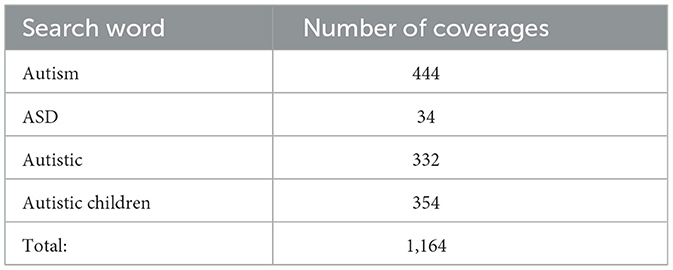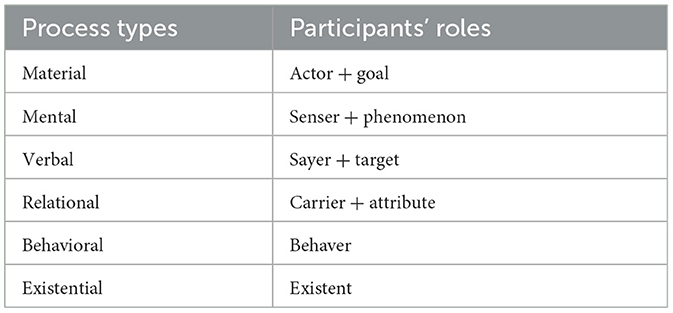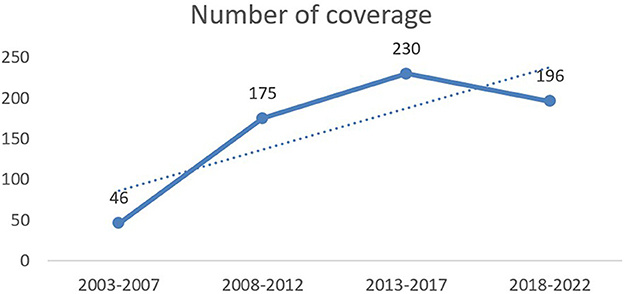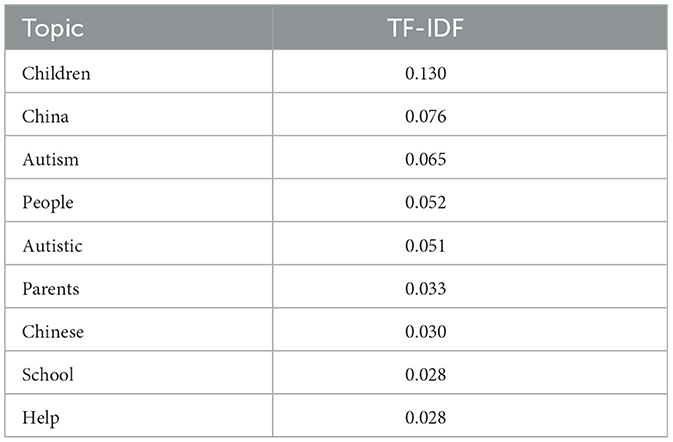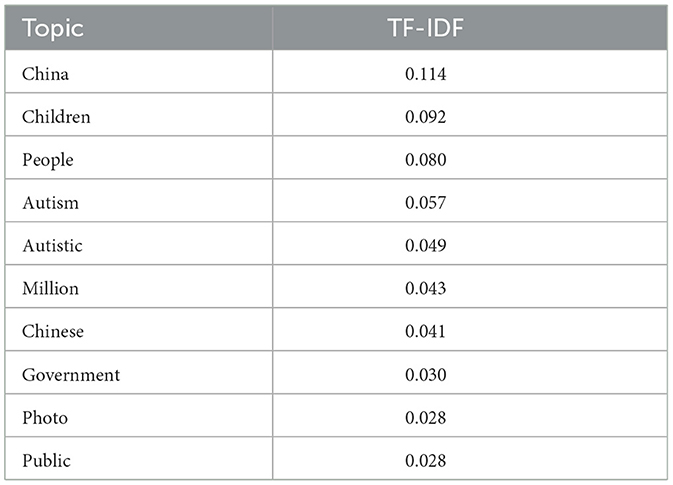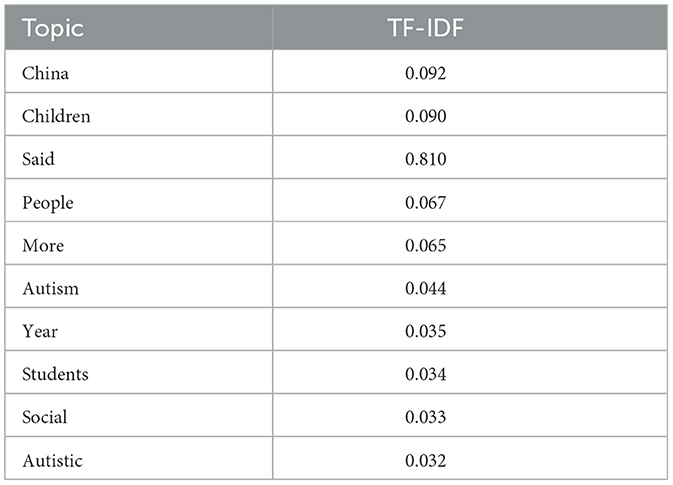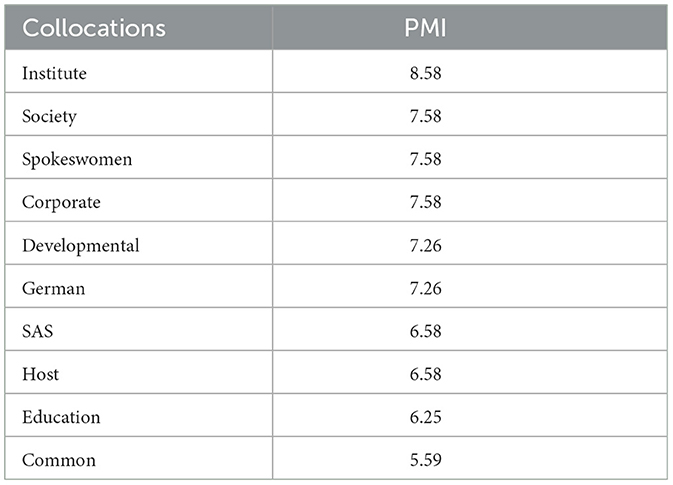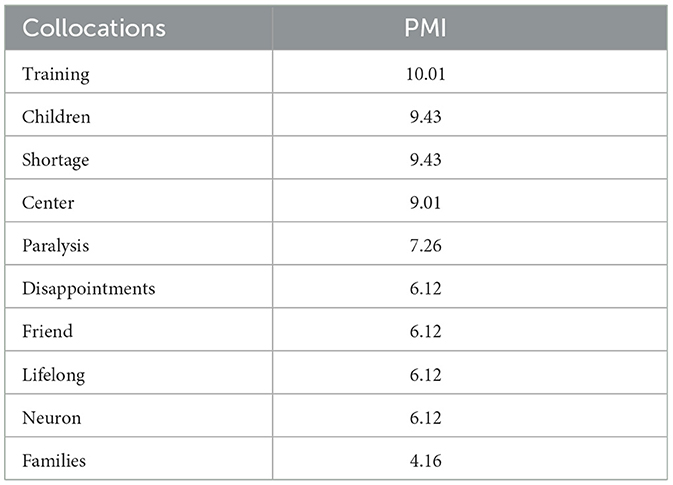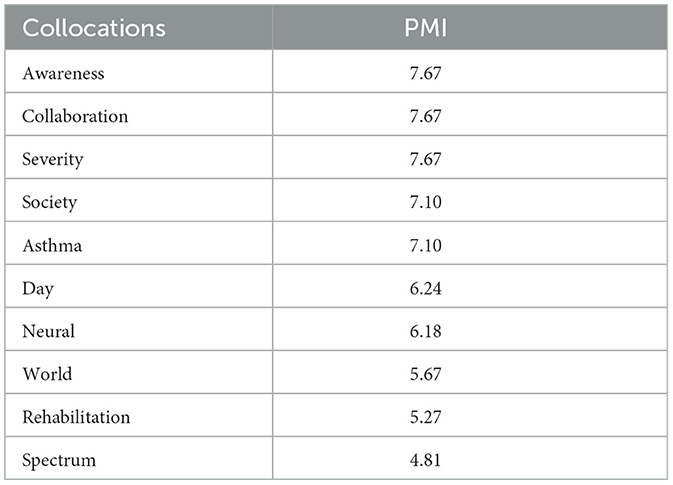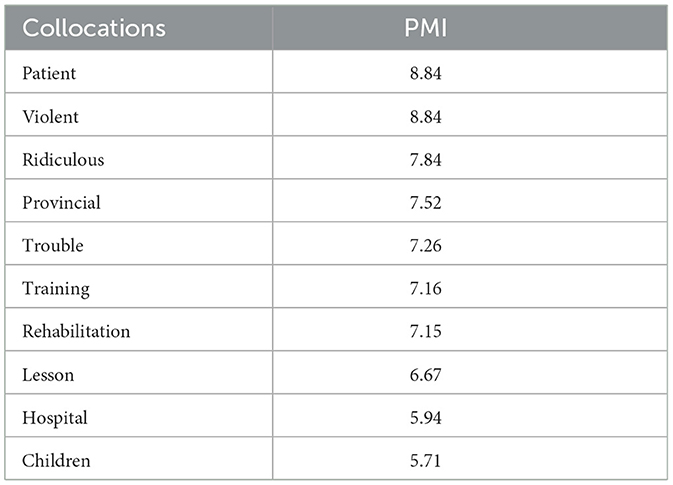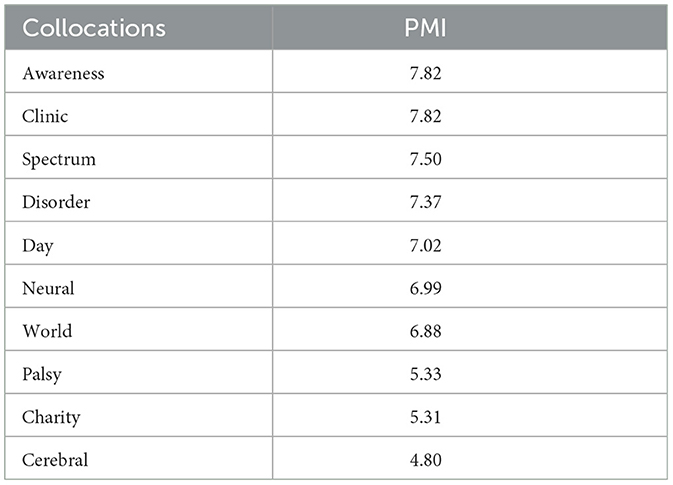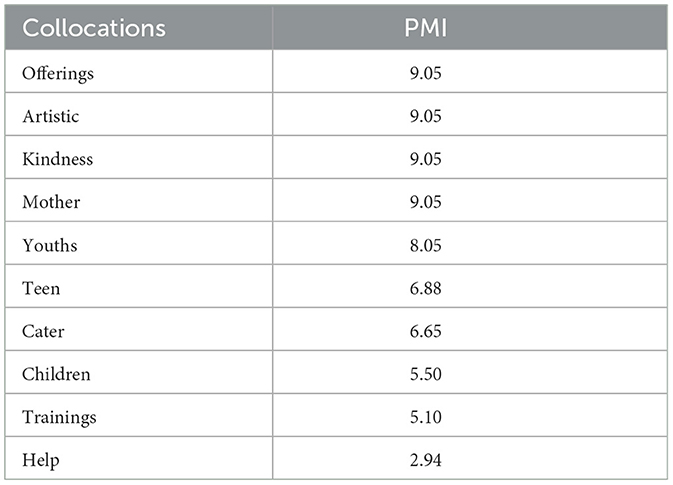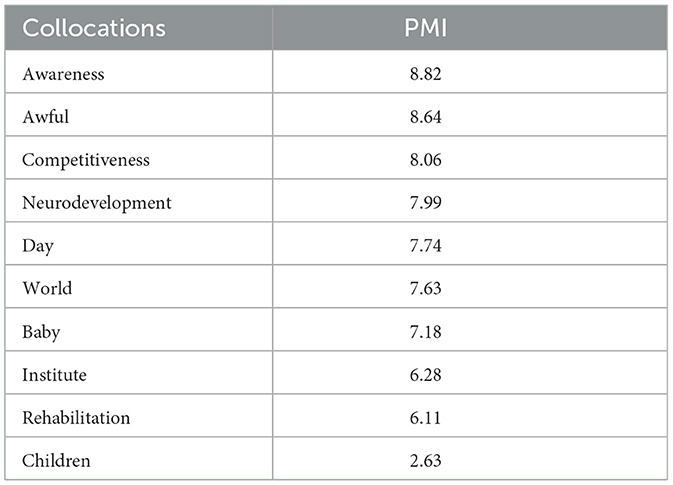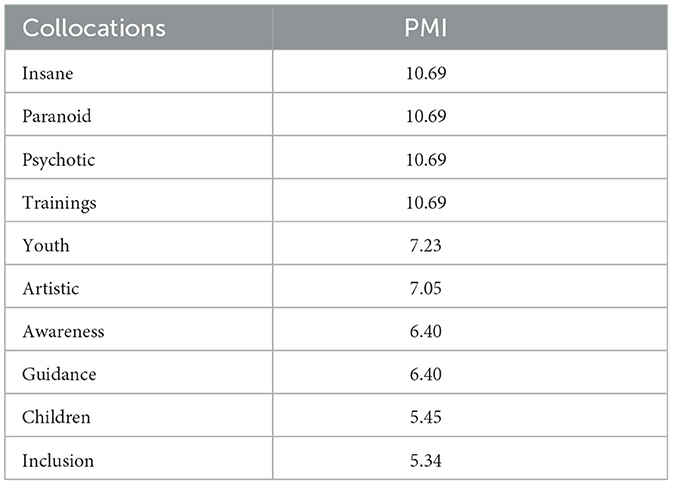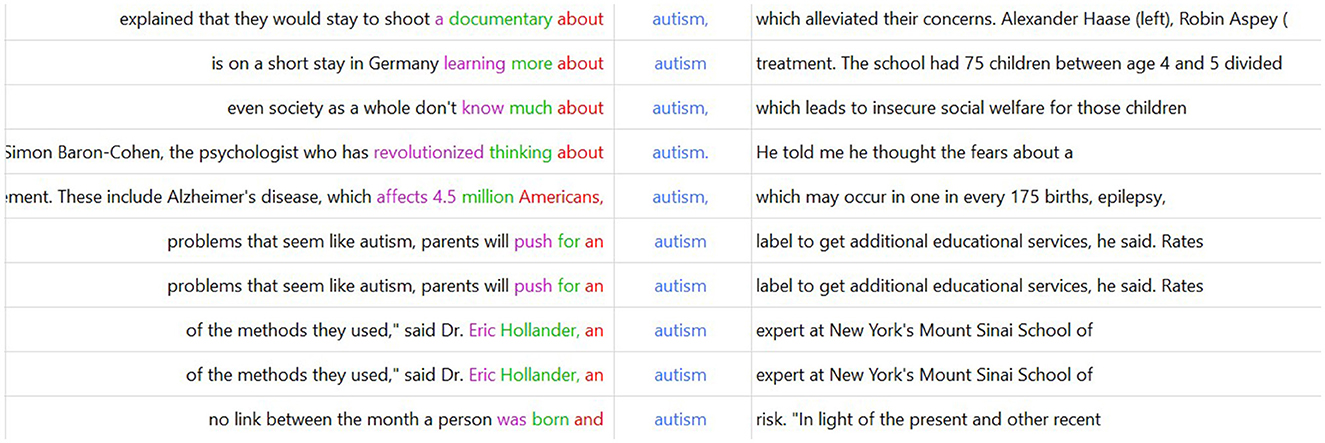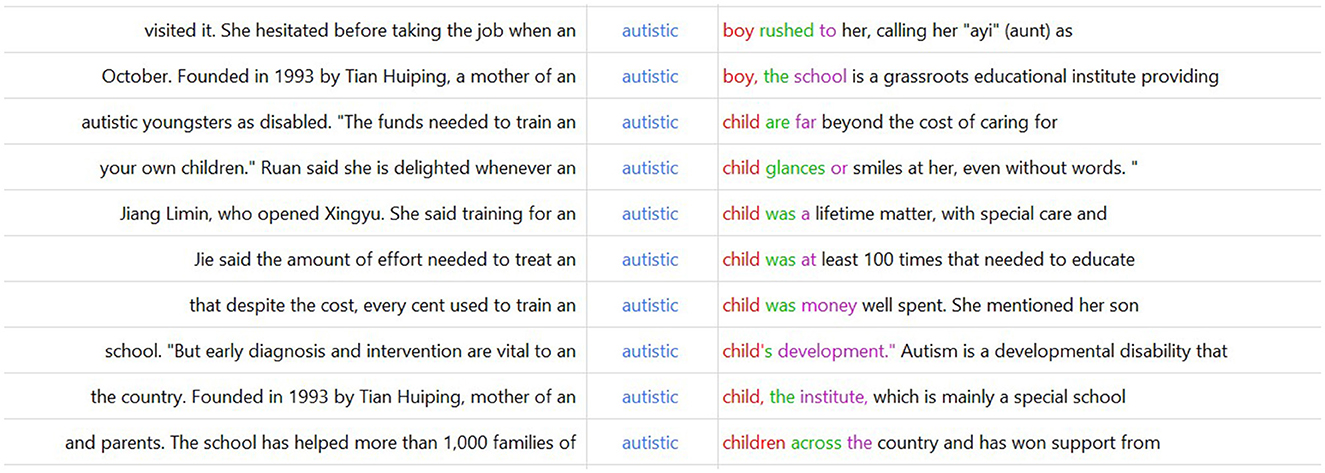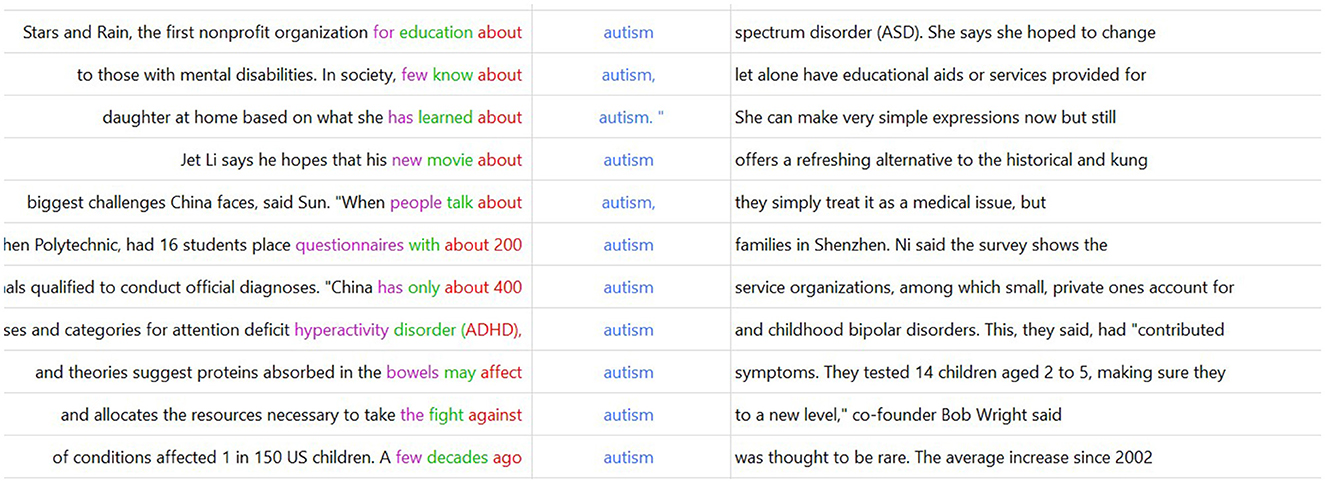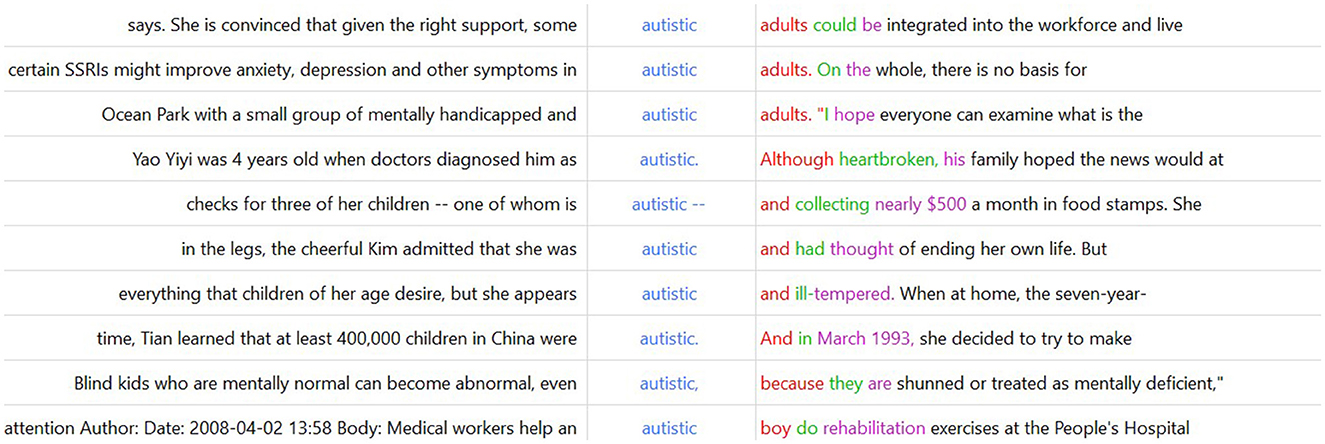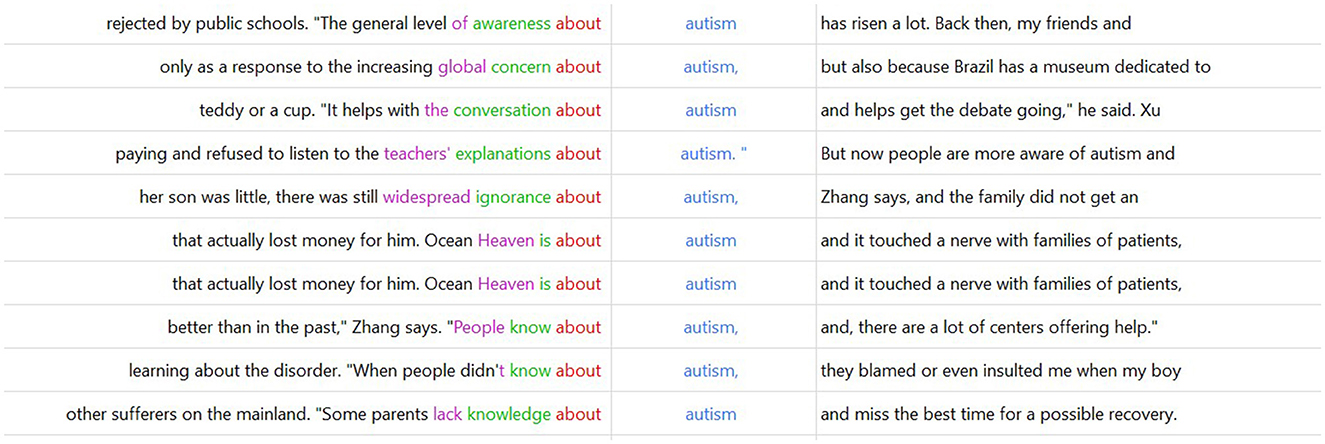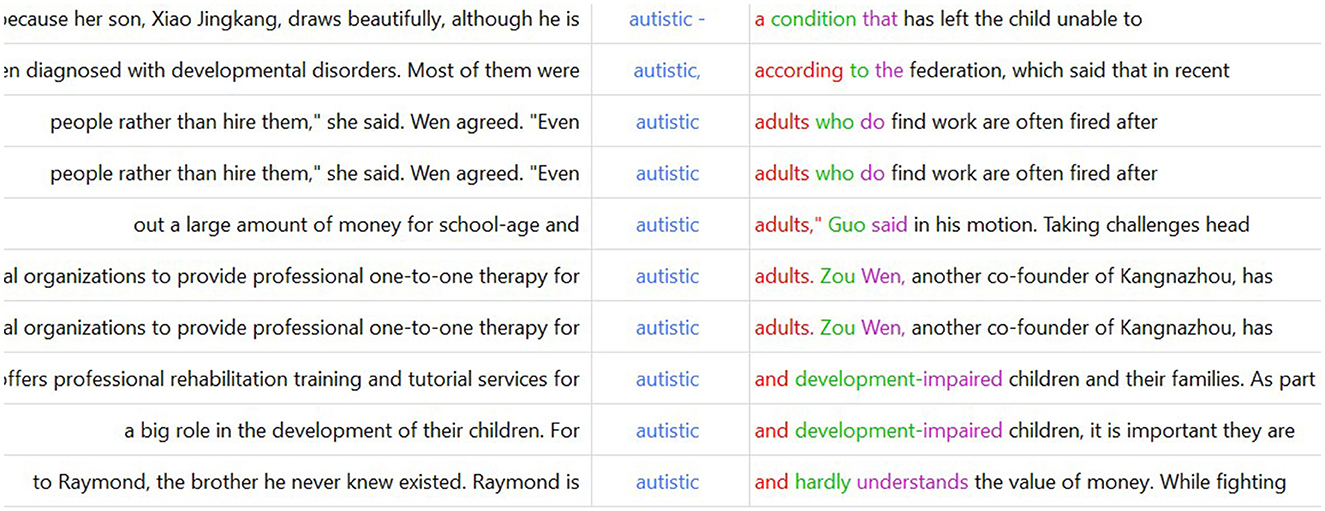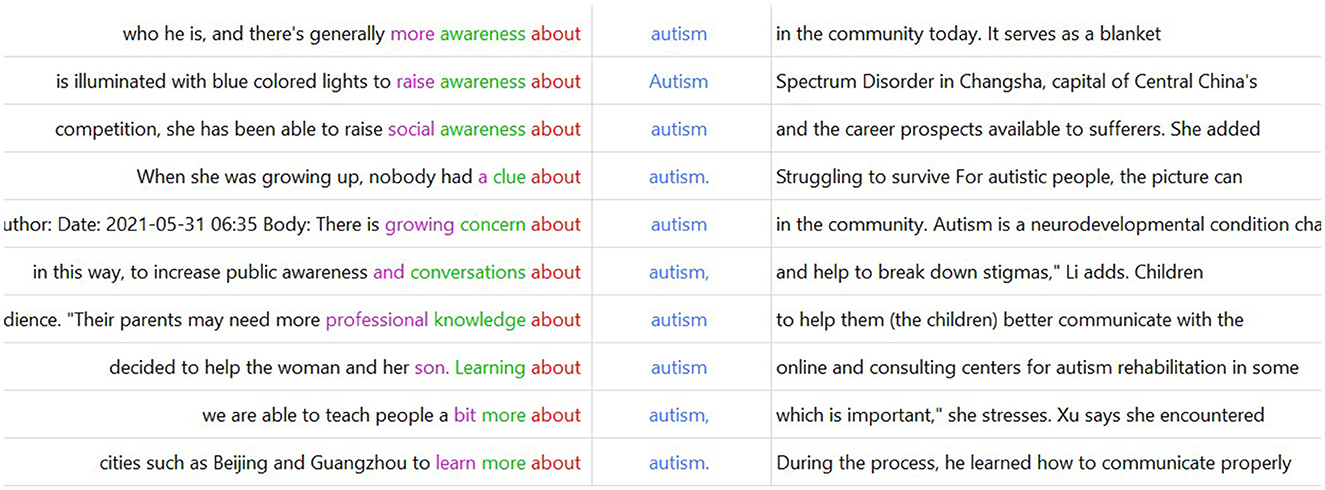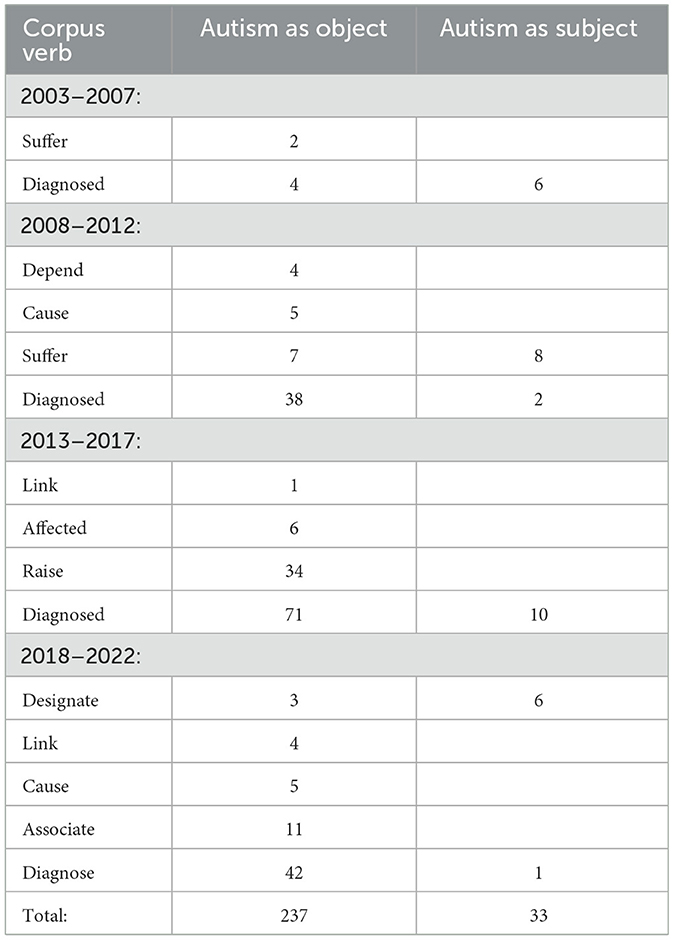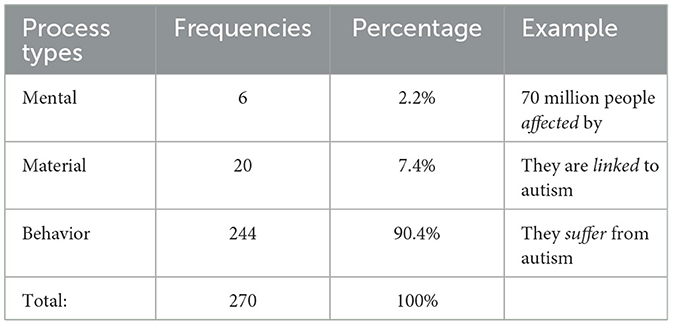- School of Foreign Languages, Zhejiang University of Finance and Economics, Hangzhou, China
Introduction: News media play an important role in shaping public perceptions of and attitudes toward people with autism. This study examines news reports about autism in China Daily over the past 20 years, from 2003 to 2022.
Methods: This study employed both quantitative and qualitative analyses.
Results: The findings reveal that news coverage on autism predominantly centers on children, with a significant shift in focus from support by family members and schools to support at the broader societal and governmental levels. Further, the overall representation of autism remains predominantly negative and rooted in prejudice. In terms of gender representation, autism is often depicted more frequently as male-oriented. However, a more diverse representation of age groups has emerged. Finally, while news media subtly convey negative attitudes toward autism, they also demonstrate a concurrent concern for the condition, reflecting a complex and nuanced attitude toward people with autism.
Discussion: Our study indicates that corpus-assisted critical discourse analysis allows researchers to compare news over time, thus offering insights into changing discourses. The analysis can also reduce bias and uncover the implicit attitudes of news media toward autism by analyzing patterns of words and discourses.
1 Introduction
Autism spectrum disorder (ASD) is a neurodevelopmental disorder that occurs worldwide (American Psychiatric Association, 2013). Autism has increasingly emerged as a significant health concern globally. In the United States, estimates from the Autism and Developmental Disabilities Monitoring Network suggest that about 1 in 36 children have been identified as having ASD (Maenner et al., 2023). Elsewhere, ASD prevalence in Asia is estimated at 0.4% (Salari et al., 2022), whereas the prevalence is 10.18 per 10,000 individuals in China (Wang et al., 2018). Although China has a lower proportional prevalence than the United States, the absolute number of individuals with autism is still significant considering the country's vast population. Nevertheless, public awareness of autism in China remains low and the misunderstandings and stereotypes surrounding ASD are numerous. In particular, stigma and biases toward people with autism and their families continue (McCabe, 2007; Tang and Bie, 2016).
Studies on representations of the autistic population have two primary research focuses: the construction of representations from the frame theory perspective (Holton et al., 2014; Jones and Harwood, 2009; McKeever, 2013; Wilkinson and McGill, 2009) and the construction of representations in national news (Billawala and Wolbring, 2014; Huws and Jones, 2011; Jones and Harwood, 2009; Lin and Ma, 2023; Robertson, 2009). However, the first type of research tends to be qualitative, potentially leading to biases due to the absence of quantitative data. The second type of research focuses on the Western media and lacks an in-depth analysis of the image of autism in China. Hence, in this study, using a combination of both quantitative and qualitative methodologies, we present a corpus-assisted critical discourse analysis (CACDA) on changes in the focus of news media and representations of autism in China Daily from 2003 to 2022. This study aims to uncover the representations of people with autism in China and attitudes of Chinese newspapers toward them.
2 Literature review
We use a mixed approach to explore the representations of people with autism in Chinese news discourse. Therefore, we review the literature from two perspectives: news discourse on ASD and a CACDA of autism.
2.1 News discourse on ASD
The press plays a vital role in informing and shaping people's attitudes toward and beliefs about a certain issue or group. The image of autism in news media is mostly based on specific frames, which refer to how the media and media professionals interpret events and issues through various linguistic means (Entman, 1993, p. 52). For example, McKeever's (2013) study of 1,517 articles revealed a consistent rise in autism coverage from 1996 to 2006 in both The New York Times and The Washington Post. In particular, the research found a decline in science-based frames over time, whereas policy-related frames surged. Clarke's (2012) investigation further uncovered the portrayal of children with autism within the context of cause framing, where vaccination emerged as a prominent factor attributed to autism in popular magazines. Additionally, Holton et al.'s (2014) analysis demonstrated that “loss frames” emphasizing the negative consequences of autism were more prevalent in media coverage than “gain frames” highlighting potential treatments and cures, across a sample of 473 articles. The above studies were under typical frames in the field of journalism, and few studies have dealt with the field of linguistics.
A high prevalence of negative stereotypes of ASD has been found in different newspapers. For example, Jones and Harwood (2009) revealed that Australian newspapers regarded children with autism as dangerous, uncontrollable, and unloved. Billawala and Wolbring (2014) collected newspaper articles from The New York Times, which portrayed the image of people with autism based on the disability model. In the UK press, Huws and Jones (2011) and Robertson (2009) arrived at contrasting conclusions in their respective studies. The former discovered stereotypical representations of autism in the media between 1999 and 2008, whereas the latter reported that discrimination and negative depictions of autism were not prominent in five national UK newspapers.
Another line of study has found that the portrayal of autism is closely related to the focus of news coverage. Lewin and Akhtar (2021), after analyzing 315 reports of autism coverage between 2007 and 2016, observed a shift in emphasis from cause and cure toward acceptance and accommodation. Yu and Farrell (2020) found that newspapers tended to focus more on cues related to the lack of social skills rather than physical appearance cues when reporting on autism between 1998 and 2013. Pesonen et al. (2021) noted that some articles in Finland's largest newspaper adopted clinical perspectives, whereas others addressed societal aspects relevant to autism. In summary, the focus of international news discourse has shifted from the physical deficits of autism to a greater emphasis on social impairment (Reindal, 2008; Shakespeare, 2006, 2010). However, it remains unclear how the image of autism is presented in Chinese news media and its specific focus on autism.
Compared with the extensive literature on media representations of autism in Western countries, there is a paucity of relevant studies in China. Some exceptions are Bie and Tang (2014) and Tang and Bie (2016). Bie and Tang (2014) surveyed five leading Chinese newspapers and conducted an analysis from four perspectives: issue framing, scientific framing, source framing, and solution framing. Tang and Bie (2016) explored the occurrence of stigmatizing cues (including peril, mark, and shame) and challenging cues (including personification, hope, and fight) in news reports on autism. They found that the most frequently used challenging cues were personification and hope, but their percentage of usage significantly decreased from 2003 to 2012. The most common stigmatizing cue was peril. The use of shame cues was relatively infrequent, but it increased significantly from 2002 to 2012. Based on the framework of multimodal critical discourse analysis (CDA), Lin and Ma (2023) explored the visual images related to autism in People's Daily (2008–2019). The study revealed that people with autism are primarily represented as having a deficit in communication, exhibiting deviations from the norm, being pathological in nature, and requiring both medical intervention and familial assistance.
As noted in the Introduction, research on autism is primarily based on qualitative analyses such as content analysis (Bie and Tang, 2014; Botha and Cage, 2022; Clarke, 2012; Holton et al., 2012, 2014; Jones and Harwood, 2009; Lin and Ma, 2023; Tang and Bie, 2016). For instance, Boyce (2006) used content analysis to explore the reporting of the autism vaccine controversy by British newspapers, television, and radio in 2002. In a similar vein, Clarke (2008) conducted a content analysis of 279 articles from three U.S. and three U.K. newspapers spanning 1998 to 2006 to assess the balance in the media portrayal of the purported association between autism and the MMR vaccine. Additionally, Holton et al. (2012) used content analysis to investigate global media coverage of the MMR/autism controversy across a 13-year period. Such qualitative analyses necessitate the development of a codebook, but variations in research foci among researchers can lead to disparities in coding methods, thereby posing the potential risk of subjective and selective interpretations (Breeze, 2011).
The combination of qualitative and quantitative methods has recently been used to explore representations of autism. Karaminis et al. (2023) pioneered the synergistic use of CACDA to investigate the lexicogrammatical patterns used to report autism and expose explicit and implicit attitudes toward autism in British newspapers. Their study employed collocation analysis, semantic preference analysis, and discourse prosody analysis to analyze the news reported by UK newspapers from 2011 to 2020. The results showed that UK newspapers continued to emphasize the adversities linked to autism and frequently resorted to negative language. However, currently, no researchers have utilized the CACDA method to examine the portrayal of autism in Chinese news media.
2.2 Corpus-assisted critical discourse analysis
CACDA is a synergistic approach that combines CDA with corpus linguistics. CDA focuses on the relationships between language, power, politics, society, and ideology by studying the discourses (Fairclough, 2001, p. 121–138). The transitivity system is considered an important analytical tool in CDA. News language not only conveys information but also influences readers' values. Transitivity analysis helps reveal the different positions and viewpoints of reporters reflected in the underlying meaning of news language.
Common methods of corpus linguistics used in research include frequency, keywords, collocation, and concordance analysis (Paterson and Gregory, 2019). Frequency analysis is a methodological approach, as it allows researchers to count the number of occurrences of a specific element. Based on the frequency, lists of keywords can be generated. Keyness is defined as the statistically significant increase in the frequency of specific words or clusters within the corpus being analyzed compared with another corpus, whether it be a general reference corpus or a comparable specialized corpus. Its ultimate aim is to highlight the “aboutness” of a text or a homogeneous corpus, thereby revealing its core topic and the pivotal elements that constitute its content. In this study, we use this technique to uncover the specific focus of Chinese news media on autism. Collocation explores the relationships between co-occurring words in naturally occurring language (Baker, 2006). Collocation is invaluable for CDA, as it not only offers researchers the semantic definition of a word but also elucidates its implicit aspects within a discourse, providing a deeper understanding of its contextual usage (Forest, 2007). The most common statistical tests for measuring collocation are mutual information (MI), pointwise mutual information (PMI), Z-score, T-score, and log-likelihood. These quantitative methods are not only used to provide data support and assist in qualitative analysis; they also rely on qualitative analysis to interpret the quantitative data. Concordance analysis stands as a qualitative method that equips researchers with the capability to comprehensively explore all instances of a designated search term within a corpus, inclusive of its immediate co-text. This approach facilitates a contextual analysis of linguistic features considering the contextual nuances understood by the analyst and can make inferences from the surrounding text.
2.3 Research questions
Our study aims to provide new insights through a systematic investigation of the press representation of autism in China over a 20-year period. By adopting CACDA, we examine all news coverage in China Daily between 2003 and 2022 to assess how portrayals of autism have changed over time. The following research questions are addressed.
1. What is the focus of the coverage of autism in China Daily? Has it changed?
2. How are individuals with autism portrayed in China Daily?
3. What hidden attitudes are embodied in China Daily?
By quantifying the keywords, we aim to examine the shifting focus of news coverage, while quantifying the intensity of collocations allows us to delve into the portrayal of autism. Qualitatively, we conduct concordance analysis to further explore representations of autism in this context. Additionally, transitivity analysis is used to uncover the implicit attitudes of Chinese news media toward autism.
3 Methodology
3.1 Corpus construction
China Daily, established in 1981, stands as one of the most influential media outlets in China, with a substantial global reach, averaging more than one million copies in circulation worldwide (China Daily, n.d.). Renowned for its role in disseminating information about China to the world, China Daily's reports not only reflect the attitudes of the Chinese government on various topics but also communicate China's perspectives and plans to international audiences.
We used a script in Python (version 3.11) run through the Integrated Development Environment PyCharm to collect the data. The search period ran from January 2003 to December 2022. We searched for the words “autism,” “autistic children,” “ASD,” and “autistic” to capture all reports related to autism. The script records the news content and basic information (including news title, date, and author), organizing them into rows. Detailed data are presented in Table 1. Following the manual removal of duplicate news articles, 645 articles (555,466 words) remained.
3.2 Corpus-assisted critical discourse analysis
3.2.1 Keyword analysis
Keyword analysis identifies the focus of the corpus in a complex way (Baker, 2004). Term frequency-inverse document frequency (TF-IDF) is a statistical measure that evaluates how relevant a word is to a document in a collection of documents. It provides considerably more information than just the number of times a word appears in a document. Simply put, TF-IDF calculates how important a word is for a document in a corpus.TF-IDF includes two parts: TF means the normalized frequency of the occurrence of a word in a document and IDF refers to a logarithm of the total number of documents divided by the number of documents in which the term appears. The calculation formula is as follows:
TF-IDF is proportional to the number of occurrences of a word in a text. If the TF-IDF value of a word is high, it means that it occurs many times in the text. We used the Jieba package in Python to automatically compute the TF-IDF value for each word, ensuring both efficiency and precision in the process.
3.2.2 Collocation analysis
In this study, we used the corpus software Wordless8.0 (Scott, 2022) to identify the collocations. First, we only chose AUTISM or AUTISTIC as nodes with the span [L5, R5] to obtain the collocations. Second, the collocations were filtered using two criteria: strength and frequency. PMI is one of several cohesion metrics advanced in corpus linguistics to extract collocations (Bouma, 2009; Evert, 2008). This measurement was introduced into lexicography by Church and Hanks (1990). PMI measures how much the actual probability of a co-occurrence of events p(ab) differs from what we would expect it to be on the basis of the probabilities of the individual events and assumption of independence p(a)p(b). If two words occur more often than one word would be expected, they receive a higher PMI score. In short, PMI was used to measure the strength of the cohesion between words. We selected the nouns and adjectives (PMI>3) that collocate with AUTISM and AUTISTIC. The calculation formula is as follows:
The second criterion was evaluated by frequency, that is, the number of occurrences with AUTISM in the corpus.
3.2.3 Concordance analysis
In this study, AntConc 3.3.5 was used to retrieve the concordance lines of the search words AUTISM and AUTISTIC. AntConc is a freeware corpus analysis tool for concordance and text analysis. This tool provides a “key word in context” display, allowing for a comprehensive analysis of the linguistic context surrounding search terms. As the search word AUTISM is a noun, we chose “sort to left, and order by value with the span 3L.” By contrast, as the search word AUTISTIC is an adjective, we chose “sort to right and order by value with the span 3R.”
3.2.4 Transitivity analysis
Transitivity is defined as a network of systems that address outside-world experiences or inner thoughts in the form of “processes.” It comprises six process types: material, mental, relational, verbal, existential, and behavioral processes (Halliday, 1967; Halliday and Matthiessen, 2014). Table 2 lists the types of processes and participants' roles, as expressed by the transitivity system. In this study, we examined whether AUTISM and AUTISTIC co-occurred with verbs expressing particular actions.
4 Results
4.1 Number of reports in each period
To explore changes in the representation of autism in news media, we divided the 20-year period into four periods, with each period covering 5 years, considering social and political factors, as shown in Figure 1.
The first 5 years (2003–2007) were selected as the initial period, since the UN General Assembly adopted a resolution in 2007 designating April 2 as World Autism Awareness Day. In China, autism was not officially recognized by the government as a psychiatric disorder until 2006. In this period, the number of reports was 46, accounting for only 7.1% of the total.
The 5 years from 2008 to 2012 were the second period. During this period, the Chinese government formulated its policy on autism. For example, the Chinese Mental Health Association established a committee in Beijing in 2009. The Child Autism Diagnosis, Treatment, and Rehabilitation Guideline was issued by the Ministry of Health in 2010. The 12th Five-year Implementation Plan for Mental Disorder Prevention, Treatment, and Rehabilitation was issued by the China Disabled Persons' Federation in 2012. We assume that the increase in news coverage during this period was due to institutional settings and government advocacy, which contributed to the rise in autism reports.
The period from 2013 to 2017 was considered the third phase. In 2013, the DSM-V altered the definition and meaning of autism. Autism, Asperger's, and childhood disintegrative disorder were combined into ASD. In 2017, the State Council officially approved August 25 as Disability Prevention Day to raise public awareness of disability prevention. These two important social and political events in China and abroad contributed to the increase in relevant reports on autism, with a total of 230 reports, accounting for 37%.
The period spanning 2018 to 2022 constituted the last phase. The number of reports showed a downward trend. However, there was a growing need for news media to inform the public (Chen et al., 2011; Hua and Yang, 2013) because Chinese families with autistic members were suffering significant pressure from stigma and shame (McCabe, 2007, p. 48).
In summary, during the 20 years studied (2003–2022), the number of stories on autism published each year displayed a clear upward trend despite a slight decline in the last 5 years. The rising number of reports intuitively reflects the increasing attention of Chinese news media on people with autism, possibly driven by the rise in the number of cases.
4.2 Keyword analysis
The keywords of the four periods were obtained using Python (see Tables 3–6). We conducted a diachronic analysis of the keywords. Different keywords reflected different emphases in the news discourse in these four periods. First, the focus of continuous attention in the news discourse was on children with autism. It was evident that the keyword children appeared in all four stages and was always ranked in the top two. Second, the focus of assistance for autism expanded from family members and teachers to the social level. For example, the keywords parents and school only appeared in the first two periods (see Tables 3, 4), whereas government, public, and social appeared in the third and fourth periods (see Tables 5, 6), indicating that the public progressively paid attention to people with autism from 2013 to 2022.
4.3 Collocation analysis
4.3.1 Period one (2003–2007)
In terms of collocations with AUTISM (Table 7), owing to the spread of the SARS (PMI = 6.58) virus in China, public focus on autism was relatively low. The collocation of “education” with AUTISM had a PMI value of 6.25. This indicates that the news paid attention to the education of people with autism during this period.
In terms of collocations with AUTISTIC, “training” had the highest PMI value (10.01), followed by “children” (PMI=9.43). These two collocations indicate that the news paid attention to training for children with autism, especially for family members [see example (1)]. This could explain why the PMI value of “families” with autistic scores was 4.16 (Table 8). Overall, the collocations with both AUTISM and AUTISTIC show that public awareness of autism was low in the initial period and that the autistic population received little attention from society.
Example:
(1) “The three-month training is just a small battle those families have won over autism. They will return home to fight with the old feeling of sorrow and overcome future difficulties without professional assistance.” The filmmakers say they hoped a platform could be created that would allow autistic families to receive the lifelong financial and scientific support their children need (June 27, 2007).
4.3.2 Period two (2008–2012)
The highest intensity collocations with AUTISM were “awareness” (PMI = 7.66) and “collaboration” (PMI = 7.66) (Table 9). Example (2) shows the increase in public awareness of autism and shifts in misunderstandings about people with autism. Example (3) shows that the United States began to focus on regional and international medical collaborations to treat autism. The collocations “World” (PMI = 5.67) and “day” (PMI = 6.24) had high values, which may be due to the influence of World Autism Awareness Day. The word “rehabilitation” had a PMI value of 5.27, which suggests that the need for healthcare resources, especially for rehabilitation treatment resources and conditions for people with autism, was urgent in this period [see example (4)].
Most collocations with autistic (Table 10) were associated with stigma, such as “patient” (PMI = 8.84), “violent” (PMI = 8.84), and “ridiculous” (PMI = 7.84). The representation of people with autism was more negative than in the first phase and the stigma persisted. Hence, the persistence of stereotypical beliefs about autism among the public remained evident despite the awareness campaigns on World Autism Awareness Day.
Examples:
(2) By bringing autism awareness to a global level, we will give a voice to the millions of children who are misunderstood, abused, and looking for help (April 7, 2008).
(3) The statement came as Ban addressed a United Nations panel discussion aimed at strengthening regional and international collaboration to help treat the developmental disorder (April 7, 2011).
(4) The China Disabled Persons' Federation says more than 6,000 disabled survivors badly need medical treatment, surgery, rehabilitation, and artificial limbs (November 27, 2008).
4.3.3 Period three (2013–2017)
“Awareness” and “clinical” had the highest collocations with AUTISM (Table 11), both with a PMI value of 7.82. Example (5) suggests that clinicians began to explore the etiology of autism. From the perspective of clinical medicine, news reports were not only publicizing the latest research findings but also objectively popularizing autism to the public. In addition, the collocations of “charity” (PMI = 5.31) highlighted news reports' humanistic concern for the autistic population.
Table 12 illustrates the collocations of family roles and age groups with AUTISTIC. Among the family roles, the most prominent was “mother” (PMI= 9.05). Among the age groups, the word ‘youth' had the highest PMI (8.05). Moreover, some collocations (e.g., offering, training, and help) indicate that the autistic population was gradually receiving more attention. In this phase, public awareness increased steadily and the image of the autism population tended to center on younger people.
Example:
(5) “This study offers the promise of a major new tool for understanding the causes of major developmental disorders of the brain... as well as testing possible treatments,” said Paul Matthews, a professor of clinical neuroscience at Imperial College London, who was not involved in the research but was impressed with its results (August 29, 2013).
4.3.4 Period four (2018–2022)
In terms of collocation with AUTISM (Table 13), the PMI of rehabilitation (6.11) with AUTISM was higher than that in the second phase. Simultaneously, the collocation “institutes” (PMI=6.28) occurred, which meant that more medical resources and better rehabilitation conditions could be provided for patients with autism (see Example 6).
During this period, the collocations with AUTISTIC were mainly related to disability and medical terms such as insane (PMI = 10.69), paranoid (PMI = 10.69) and psychotic (PMI = 10.69) (Table 14). At the same time, the news was paying more attention to training people with autism (PMI=10.69).
Although the descriptions of autistic individuals in the news still had a negative connotation to some extent, the PMI value of the word “inclusion” was as high as 5.34, which strongly indicates that the reports gradually show an inclusive attitude toward autistic individuals. At the same time, this stage coincided with the COVID-19 pandemic, which had a profound impact on young children. Many of these children experienced the predicament of social isolation.
Specifically, the long-term lockdowns, strict restrictions on peer interaction, and mandatory mask-wearing measures caused by COVID-19 may constitute barriers to children's learning of facial expressions and understanding of nonverbal cues, which may further exacerbate the symptoms of autistic children. The frequent appearance of the word “inclusion” in autism-related reports is a manifestation of the media's deepening understanding of the additional challenges that autistic children may face during the pandemic and their social integration needs. It further confirms that the media is gradually shifting toward a more comprehensive, inclusive, and caring perspective when reporting on autism-related issues.
Example:
(6) The German couple, who are known by their Chinese names of Du Xuehui and Wu Zhengrong, had just completed a two-year Chinese language course when they came to visit the Hunan Disabled Persons' Federation to learn about a charitable program funded by a German organization helping the province's deaf children with speech rehabilitation training (June 8, 2021).
4.4 Concordance analysis
4.4.1 Period one (2003–2007)
In the concordance lines of AUTISM (Figure 2), the results show that there was still little understanding of autism, which led to a poor system of both education and social welfare for people with autism, as shown in example (7). The fifth concordance line shows that one in every 175 children in the United States had autism. The growing prevalence of autism and scarce social assistance created a dramatic effect, thus affecting the representations of the autistic population as well as creating anxiety for their families. Therefore, parents of children with autism had to label their children as autistic to obtain additional educational resources [see example (8)].
Most concordance lines of AUTISTIC (Figure 3) were related to age, such as boy, child, and children. This suggests that news media exhibited biases in terms of age and sex. Overall, in this phase, news media created conflicting effects by highlighting the public's low awareness of autism, in addition to the high prevalence of autism and scarcity of resources.
Example:
(7) “I believe the educational system and even society as a whole don't know much about autism, which leads to insecure social welfare for those children with special needs,” said Jiang Limin, who opened Xingyu (October 18, 2006).
(8) “Sometimes, if a child has problems that seem like autism, parents will push for an autism label to get additional educational services,” he said (February 9, 2007).
4.4.2 Period two (2008–2012)
As shown in Figure 4, the concordance lines of AUTISM reveal that the public's understanding of autism was still relatively poor. In example (9), the public simply thought that autism was only a medical problem, but the news pointed out that it is also an educational problem. In terms of social assistance, China took action at this stage. Example (10) highlights that social organizations for autism appeared in China, although their number remained relatively small.
Examining the concordance lines of AUTISTIC (Figure 5), we find that news media began to pay attention to adults with autism. Example (11) shows that adults with autism also needed help to allow them to be better integrated into social production. While public awareness of autism was still lower in these 5 years than in the previous period, assistance for the autistic population had increased significantly. Meanwhile, news media focused not only on children with autism but also on adults with autism.
Example:
(9) “When people talk about autism, they simply treat it as a medical issue, but how to take care [of] the autistic children is actually an education issue,” Sun told METRO (July 2, 2010).
(10) “China has only about 400 autism service organization[s], among which small, private ones account for more than 70 percent,” Wen said (March 30, 2012).
(11) She is convinced that given the right support, some autistic adults could be integrated into the workforce and live independent lives (April 28, 2012).
4.4.3 Period three (2013–2017)
As shown in the concordance lines with AUTISM (Figure 6), although some parents were still relatively unfamiliar with this population between 2013 and 2017, there was a notable increase in global awareness and attention to autism. Example (12) clearly shows a significant rise in public awareness, as evidenced by the fact that students with disabilities can now attend public schools.
Figure 7 shows that AUTISTIC often co-occurred with developmental impairment because ASD was often defined as a developmental disorder caused by brain differences. A gap still existed between China's social assistance and that provided internationally. As shown in example (13), international organizations were already focusing on adults with autism and providing one-on-one rehabilitation. During this period, China Daily continued to focus on public awareness and social assistance. There was a significant increase in public awareness compared with in the previous decade and international assistance for adults with autism emerged.
Examples:
(12) Since 2013, students with disabilities can no longer be rejected by public schools. “The general level of awareness about autism has risen a lot” (July 22, 2016).
(13) This year, the NGO began working with some international organizations to provide professional one-to-one therapy for autistic adults. Zou Wen, another co-founder of Kangnazhou, has a 16-year-old son with autism, Kang Changzhou (November 7, 2013).
4.4.4 Period four (2018–2022)
As shown in Figure 8, most of the concordance lines with AUTISM reflect a significant increase in public awareness of people with autism, such as more awareness about, raise awareness about, and spread awareness about. The concordance line of example (14) shows that only raising public awareness can break the stigma of autism.
The concordance lines with AUTISTIC (Figure 9) show that organizations started to mention training courses for people with autism, which aimed to enable the autistic population to acquire basic life skills. As shown in example (15), one organization used LED lights to display the work of children with autism to both raise public awareness of autism and encourage such children to acquire certain life skills.
Examples:
(14) “I wanted to create opportunities for the team to be seen by more people, and in this way, to increase public awareness and conversations about autism, and help to break down stigmas,” Li adds (September 28, 2022).
(15) An LED light show and 48 works of art by autistic children were presented in the evening on the exterior of Tianjin Tower to raise public awareness (April 2, 2021).
4.5 Transitivity analysis
In collocation analysis, while nouns and adjectives are typically emphasized, verbs play a critical role in expressing the relation between participants, the attitudes of participants, and the act of the situations. In the transitivity analysis, we first selected the verb (PMI >3). Each verb was then retrieved in the text to determine whether autism was the subject or object. The initial corpus analysis revealed 11 statistically significant verbs whose lemma forms of AUTISM and AUTISTIC appeared either as subjects (AUTISM was diagnosed) or as objects (vaccines cause AUTISM). Table 15 shows that AUTISM appeared as an object seven times more frequently than as a subject in news discourses. When AUTISM was used as an object, it often appeared in passive sentences [see example (16)]. By contrast, when AUTISM was used as a subject, news media focused on basic information about autism such as the age of onset and sex [see example (17)].
For the process types, the behavior process type was identified as the most frequently deployed (Table 16). In the behavior process, the verbs involved were suffer, diagnose, and raise. Behavior is often specific to an autistic person or a group of autistic people. The material process ranked second. The process included three verbs, namely, link, associate, and depend. Moreover, the findings show that mental processes were the least frequent process type. Finally, there was only one verb—affect—in this process type.
Examples:
(16) Higashida was just 5 years old when he was diagnosed with severe autism. Autism is a spectrum of neuro-developmental disorders that manifests itself in difficulties communicating (March 11, 2015).
(17) The specific report was as follows: Autism and related disorders continue to be diagnosed far more often in boys than girls, and in white people than black people or Hispanics (April 2, 2014).
5 Discussion and conclusions
This study used a mixed method (i.e., CACDA) to examine the focus of news media and representation of the autistic population in China Daily from 2003 to 2022. The number of reports on autism has risen consistently over the past two decades, potentially contributing to greater public awareness of ASD. To facilitate a comprehensive analysis, we divided the 20-year period into four distinct periods to examine changes in representations of autism and shifts in the focus of media coverage in China.
Regarding the first research question, our analysis reveals two key findings. First, the keyword analysis demonstrates that children with autism have consistently been the primary focus of news discourse. This finding aligns with those of Huws and Jones (2011) and Wilkinson and McGill (2009), who both observed that media representation disproportionately centers on children with autism. Wilkinson and McGill (2009) noted that the word “children” appeared 46 times in The Guardian, while words related to adults (e.g., “male,” “adult”) appeared only three times. Similarly, Huws and Jones (2011) found that British newspapers disproportionately focus on children. This overrepresentation of children with autism in news media is not merely a reflection of societal concern but also reveals underlying ideological structures within public discourse. The focus on children reinforces narratives of vulnerability and dependence, perpetuating the idea that autism is primarily a childhood issue, thereby marginalizing the experiences of autistic adults. This selective framing strengthens societal power dynamics, where children are viewed as in need of protection and intervention, while autistic adults are rendered invisible or irrelevant in the discourse. Second, the keyword analysis also indicates a shift in the focus of news coverage regarding assistance for individuals with autism—from family members and schools to society and government. In the first decade of the study period, parents and schools were cited more frequently than society and government in news coverage. This finding concurs with Bie and Tang (2014), who showed that in Chinese newspapers between 2003 and 2012, family members were the most cited source of support, reinforcing an ideology that framed autism as a private family matter rather than a public or medical issue. This narrative reflects and reinforces societal power structures by placing the responsibility of care and support primarily on the family, absolving broader societal and governmental systems from accountability.
However, the keyword and concordance analyses reveal that in the second decade of the study, news coverage began to shift, increasingly focusing on aid provided by international organizations and government bodies. This evolution reflects a changing discourse where autism is no longer seen solely as a familial concern but as a societal and global issue requiring institutional and governmental intervention. The inclusion of international organizations and government officials in autism coverage signals a rebalancing of power, where state and global institutions are now acknowledged as key stakeholders in providing support for individuals with autism. This shift is consistent with previous findings from McKeever (2013), who found that scientific experts and government officials were cited more frequently than family members in The New York Times and The Washington Post's coverage of autism. Similarly, Kang (2013) concluded that doctors were more frequently cited than family members in U.S. television news stories about autism. These shifts in discourse reflect broader ideological changes regarding the role of the state and society in addressing autism. News media play a crucial role in constructing and disseminating these ideologies, influencing how the public understands the division of responsibility between families and governments. While family members remain central to the narrative, the growing emphasis on societal and governmental responsibility highlights the evolving recognition that the issue of autism extends beyond the private sphere and into public, institutional domains. In summary, multiple voices should be included in news reports, recognizing the importance of both family members and government institutions in addressing autism. It is not only families who bear the responsibility for supporting children with autism, but also society and governments, which must offer adequate resources and interventions. Institutional power has begun to take a more prominent role, as evidenced by the American Academy of Pediatrics (AAP), which underscores the responsibility of all pediatric healthcare professionals to engage in early identification of developmental disorders as part of primary care. Additionally, China's 2022 “Service Standards for Autism Screening, Diagnosis, and Intervention and Rehabilitation for Children from 0 to 6 Years Old” issued by the National Health Commission requires all levels of health administration departments to actively promote and ensure the provision of autism services. These institutional guidelines further reflect the shift in discourse, from autism being a family issue to one that involves public health infrastructure and governmental responsibility, reinforcing the need for systemic support.
Regarding the second research question, our analysis reveals persistent negative stereotypes surrounding autism throughout the study period. The collocation analysis shows that the word “AUTISM” frequently co-occurred with negative adjectives such as “psychotic”, “violent”, and “paranoid”. This discursive association between autism and other disorders shapes public perceptions by pathologizing autism and reinforcing harmful narratives (Baker, 2006, p. 70). Similar findings were noted in Tang and Bie (2016) study, where approximately 9% of articles described people with autism as “introverted” or “unsocial”. Lin and Ma (2023) further observed that individuals with ASD were portrayed as having a communication deficit, deviating from social norms, and being pathologically different. It is important to note that the challenges inherent in autism spectrum disorder (ASD) stem from its multifactorial etiopathogenesis, involving complex genetic and environmental interactions (Rutter, 2005; Hallmayer et al., 2011). These factors contribute to the wide heterogeneity in symptoms and experiences among individuals with ASD, making it difficult for the public to fully understand the condition. Compounding this is the stigma associated with mental health disorders, which often results in individuals with ASD being perceived through a lens of deviance or inadequacy (Broady et al., 2017). This lack of understanding, combined with societal misperceptions, reinforces negative stereotypes and oversimplifies the realities of living with autism. These discursive patterns highlight the powerful role of media in constructing ideologies that stigmatize autism. By drawing connections between autism and mental disorders in such an unscientific and sensationalist manner, news reports serve to perpetuate existing power imbalances. These representations reduce individuals with autism to stereotypes, reinforcing an ideological framework that views them as socially deviant and in need of “fixing” or “containment.” Such portrayals not only deepen the public's misunderstanding but also exacerbate the marginalization of individuals with autism, shaping how they are treated both socially and institutionally. The continued use of such language sustains a discourse of deficiency and deviance, undermining the potential for more empowering representations of autism in the media.
To counter these deeply entrenched stereotypes, the media must adopt a more nuanced and objective approach in its coverage of autism. First, news outlets should offer comprehensive coverage of the causes, diverse symptoms, and available treatment options, which can enhance public awareness and reduce the stigma associated with autism. Currently, media reports rarely explore the complexities of autism diagnosis or the varying levels of severity (Levels 1, 2, or 3), leaving the public with an incomplete understanding of the condition. Greater emphasis on these distinctions would allow audiences to gain a more accurate picture of autism' s diversity, thereby dismantling the narrow and reductionist views often promoted in mainstream discourse. Furthermore, it is crucial for the media to adhere to principles of both humanism and scientific rigor, moving away from traditional medicalized discourses that pathologize disability. Instead, autism should be portrayed with respect and empathy, emphasizing the individuality and humanity of those affected (Brownlow, 2010; Cooper et al., 2017; Davidson, 2008). By challenging the dominant ideology that positions individuals with autism as fundamentally “other” or inferior, the media can play an active role in reshaping public discourse and power dynamics, presenting autism as a neurological difference rather than a deficit.
Additionally, the issue of social isolation among individuals with autism remains a central concern for multiple stakeholder groups, including autism advocates, caregivers, and service providers (Heinrich and Gullone, 2006). According to the Institute of Medicine's definition, autism at the individual level often manifests in a lack of social interaction, contact, and relationships with family, friends, neighbors, and the broader community (Peplau et al., 1982). Social interaction is a fundamental human need, and its absence can lead to isolation and loneliness, particularly for children with autism, where early experiences of social exclusion can have profound effects on their development, learning abilities, and mental and physical health. In this context, media discourse wields significant power in shaping public attitudes toward autism. Positive and realistic portrayals of individuals with autism can mitigate social isolation by fostering greater understanding and inclusion. The media has the capacity–and responsibility–to reshape societal ideologies surrounding autism, offering narratives that promote connection rather than division. By highlighting the strengths, capabilities, and diverse experiences of the autism community, news coverage can help dismantle harmful stereotypes and encourage a more inclusive, supportive social, educational, and professional environment. In doing so, the media can shift the balance of power, providing a voice to those who have long been marginalized and contributing to the creation of a society that values and supports all individuals, regardless of neurological difference.
The second key finding in the representation of autism over time is the persistent male dominance in media coverage. In the first phase of the analysis, the frequent appearance of “boy” in the concordance lines of “AUTISTIC” suggests that news media consistently focused more on males with autism. This gender bias was observed in both Chinese and British media. Karaminis et al. (2023) found that “son” was the most frequent collocate, with boys mentioned twice as often as girls. This pattern aligns with epidemiological data, as studies (Maenner et al., 2023; Loomes et al., 2017) have shown that males are significantly more likely to be diagnosed with autism than females. However, despite this statistical basis, media's emphasis on male experiences reflects a broader discourse of gendered power, where males are portrayed as the primary subjects of autism, marginalizing the experiences of females and reinforcing the notion that autism is predominantly a “male” condition. This gendered representation in media not only mirrors epidemiological data but also shapes public perception in ways that reinforce patriarchal ideologies. By prioritizing male narratives, media discourse perpetuates the invisibility of females with autism, who are already underdiagnosed due to differing symptomatology. This selective focus reinforces societal power structures, where males are positioned as the default subjects of medical and public discourse, while females are sidelined. The use of epidemiological data to justify this imbalance allows media to maintain existing gender hierarchies, shaping public understanding and influencing broader decisions in policy and healthcare that often overlook the unique challenges faced by females with autism. For more equitable representation, media must engage in more inclusive reporting that reflects the experiences of all individuals with autism, challenging these dominant ideological frameworks.
Third, we find that news media coverage of autism leans toward a more balanced representation across age groups, including both children and adults, in contrast to Karaminis et al. (2023), whose collocation analysis revealed that age/sex and family roles primarily focused on children. In our study, the collocations of “AUTISM” referring to children (e.g., child, pupil, boys) appeared 8.6 times more frequently than collocations referring to adults. This significant disparity not only highlights the media's disproportionate focus on the child population but also reflects broader societal ideologies that prioritize children's issues. The overrepresentation of children in autism coverage is rooted in a discourse that frames childhood as a period of vulnerability, thus deserving more attention and intervention. This emphasis reflects societal power structures that privilege the needs of children, aligning with cultural expectations that position children as the primary recipients of care and support. However, this focus on children also perpetuates an imbalance in public discourse, marginalizing adults with autism and reinforcing the ideological assumption that autism is predominantly a childhood condition. The comparatively lower prevalence of autism in adults is often explained through the lens of early intervention, particularly during the neuroplastic stage of 2–3 years (Zwaigenbaum et al., 2015). Early interventions during this critical period are frequently framed as preventive measures that influence developmental trajectories, potentially reducing future cases in adulthood. While this narrative emphasizes the importance of early intervention, it also risks devaluing the ongoing needs of adults with autism, contributing to their invisibility in media discourse. To challenge this imbalance, we advocate for a more inclusive media approach that highlights not only the benefits of early intervention but also the unique challenges and needs of the adult autism population. Balanced reporting is essential for fostering an inclusive support system that serves individuals with autism across all stages of life, thereby challenging the dominant ideologies that limit autism to childhood.
Regarding the third research question, this study uncovers the presence of negative attitudes in the Chinese press toward autism. The transitivity analysis reveals that “autism” was more frequently used as an object rather than a subject, indicating a discursive tendency to position individuals with autism as passive recipients of actions, rather than agents with autonomy. This linguistic choice reflects broader power dynamics and ideological structures that contribute to the marginalization of people with autism. By consistently objectifying autism, the media reinforces a narrative of dependency, framing individuals with autism as subjects of external control, intervention, or management rather than active participants in society. Moreover, the analysis shows that news media overwhelmingly focused on behavioral cues (90.4%) rather than mental deficit cues (2.2%) over time. Halliday (1967) posits that behavioral processes represent the external manifestations of inner experiences, linking actions to conscious processes and physiological states. However, certain behavioral verbs carry negative semantic prosody, subtly contributing to stigmatization. For example, phrases such as “mentally” impaired children and those who suffer from autism and cerebral paralysis use behavioral verbs that imply a sense of burden or affliction, reinforcing harmful stereotypes. Such language constructs a narrative of autism as a condition that needs to be “fixed” or “managed,” thus perpetuating the power imbalance between neurotypical and neurodivergent individuals. Despite these problematic representations, further analysis reveals attempts by the media to promote positive actions taken by the government and society. Reports highlighting events like World Autism Awareness Day on April 2 demonstrate growing efforts to increase awareness and foster governmental and charitable engagement with autism issues. However, these efforts, while commendable, risk being overshadowed by the dominant narrative of autism as a deficit or problem to be solved. To challenge these entrenched discourses, we advocate for the press to adopt a more balanced and nuanced approach in its coverage of autism. As a powerful disseminator of scientific and social information, the media holds the ideological power to either reinforce or dismantle discriminatory narratives. By collaborating with self-advocacy groups like the neurodiversity movement, media outlets can shift the discourse toward one that recognizes and respects the autonomy and humanity of individuals with autism. Promoting the development of a “positive autism identity” (Cooper et al., 2017) within media representations can foster greater societal acceptance and understanding, ultimately challenging the ideological structures that marginalize people with autism.
To summarize, our study demonstrates that using CACDA allows researchers to compare news over time, thus offering insights into changing discourses. CACDA can also reduce bias and uncover the implicit attitudes of news media toward autism by analyzing patterns of words and discourses. Our research should thus complement the findings of earlier studies in China and offer fresh insights into the nature of these implicit attitudes. Furthermore, we expect this study's findings to make the Chinese public more aware of autism and hence more impartial toward people with autism.
This study has some limitations. First, the representativeness of our sample is limited, as we focused solely on China Daily. While this periodical is a prominent national newspaper in China that provides valuable insights into shifts in portrayals of autism and media focus over the past two decades, it cannot describe the entirety of the press representation of autism in China. Future studies could expand the corpus sources to collect more Chinese reports on autism and better present the image of autism. Moreover, conducting cross-cultural studies by collecting autism-related reports from different countries could illuminate variations in attitudes toward autism globally. Second, our study exclusively examined print media, overlooking the significance of digital media platforms. It would also be interesting to explore the representation of people with autism in digital media such as movies and TV, which might also leave a strong impact on the public. In this way, the image of autism could become more accurate, complex, and diverse.
Data availability statement
The original contributions presented in the study are included in the article/supplementary material, further inquiries can be directed to the corresponding author.
Author contributions
WZ: Conceptualization, Data curation, Formal analysis, Investigation, Methodology, Writing – original draft. WG: Supervision, Validation, Writing – review & editing.
Funding
The author(s) declare financial support was received for the research, authorship, and/or publication of this article. This study was supported by China Scholarship Council (CSC) Overseas Training Program for Young Key Teachers (No.202309590001) and Zhejiang University of Finance and Economics research project “Comparative Study on Narrative Ability of Chinese ASD and TD Children: Quantitative Analysis Based on Macro and Micro Structures” (NO.23XJKT059).
Acknowledgments
We thank the reviewers for their thoughtful comments and suggestions on the earlier drafts.
Conflict of interest
The authors declare that the research was conducted in the absence of any commercial or financial relationships that could be construed as a potential conflict of interest.
Publisher's note
All claims expressed in this article are solely those of the authors and do not necessarily represent those of their affiliated organizations, or those of the publisher, the editors and the reviewers. Any product that may be evaluated in this article, or claim that may be made by its manufacturer, is not guaranteed or endorsed by the publisher.
References
American Psychiatric Association (2013). Diagnostic and Statistical Manual of Mental Disorders (5th ed.). Washington: American Psychiatric Association.
Baker, P. (2004). Querying keywords: questions of difference, frequency, and sense in keywords analysis. J. English Linguist. 32, 346–359. doi: 10.1177/0075424204269894
Bie, B., and Tang, L. (2014). Representation of autism in leading newspapers in China: a content analysis. Health Commun. 30, 884–893. doi: 10.1080/10410236.2014.889063
Billawala, A. S., and Wolbring, G. (2014). Analyzing the discourse surrounding autism in the New York Times using an ableism lens. Disab. Stud. Quart. 34:3348. doi: 10.18061/dsq.v34i1.3348
Botha, M., and Cage, E. (2022). ‘Autism research is in crisis': a mixed method study of researcher's constructions of autistic people and autism research. Front. Psychol. 13:1050897. doi: 10.3389/fpsyg.2022.1050897
Bouma, G. (2009). “Normalized (pointwise) mutual information in collocation extraction,” in Von der Form zur Bedeutung: Texte Automatisch Verarbeiten/From Form to Meaning: Processing Texts Automatically, Proceedings of the Biennial GSCL Conference 2009 (Tübingen: Gunter Narr Verlag), 31–40.
Boyce, T. (2006). Journalism and expertise. Journal. Stud. 7, 889–906. doi: 10.1080/14616700600980652
Breeze, R. (2011). Critical discourse analysis and its critics. Pragmatics 21, 493–525. doi: 10.1075/prag.21.4.01bre
Broady, T., Stoyles, G., and Morse, C. (2017). Understanding carers' lived experience of stigma: the voice of families with a child on the autism spectrum. Health Soc. Care Community 25, 224–233. doi: 10.1111/hsc.12297
Brownlow, C. (2010). Presenting the self: negotiating a label of autism. J. Intellect. Dev. Disab. 35, 14–21. doi: 10.3109/13668250903496336
Chen, S., Bai, X., and Zhang, R. (2011). The symptom, diagnosis and treatment for autism spectrum disorder. Adv. Psychol. Sci. 19, 60–72.
China Daily (n.d.). About China Daily Group. Available at: https://www.chinadaily.com.cn/e/static_e/about (accessed June 18, 2023).
Church, K. W., and Hanks, P. (1990). Word association norms, mutual information, and lexicography. Comp. Linguist. 16, 22–29.
Clarke, C. E. (2008). A question of balance: the autism-vaccine controversy in the British and American elite press. Sci. Commun. 30, 77–107. doi: 10.1177/1075547008320262
Clarke, J. N. (2012). Representations of autism in US magazines for women in comparison to the general audience. J. Childr. Media 6, 182–197. doi: 10.1080/17482798.2011.587143
Cooper, K., Smith, L. G. E., and Russell, A. (2017). Social identity, self-esteem, and mental health in autism. Eur. J. Soc. Psychol. 47, 844–854. doi: 10.1002/ejsp.2297
Davidson, J. (2008). Autistic culture online: virtual communication and cultural expression on the spectrum. Soc. Cultu. Geog. 9, 791–806. doi: 10.1080/14649360802382586
Entman, R. M. (1993). Framing: Toward clarification of a fractured paradigm. J. Commun. 43, 51–58. doi: 10.1111/j.1460-2466.1993.tb01304.x
Evert, S. (2008). “Corpora and collocations,” in Corpus Linguistics: An International Handbook, eds. A. Ludeling and M. Kyto (Berlin: W. de Gruyter), 1212–1248.
Fairclough, N. (2001). “Critical discourse analysis as a method in social scientific research,” in Methods in Critical Discourse analysis, eds. R. Wodak and M. Meyer (England: Sage), 121–138.
Forest, R. W. (2007). ‘Tell Us What You Really Think': Collocation and Discourse in an Intertextual Corpus (doctoral thesis) Hong Kong: City University of Hong Kong.
Halliday, M. A. K. (1967). Notes on transitivity and theme in English: part 2. J. Linguist. 3, 199–244. doi: 10.1017/S0022226700016613
Halliday, M. A. K., and Matthiessen, C. M. (2014). An Introduction to Functional Grammar (3rd ed.). London: Routledge.
Hallmayer, J., Cleveland, S., Torres, A., Phillips, J., Cohen, B., Torigoe, T., et al. (2011). Genetic heritability and shared environmental factors among twin pairs with autism. Arch. Gen. Psychiatry 68, 1095–1102. doi: 10.1001/archgenpsychiatry.2011.76
Heinrich, L. M., and Gullone, E. (2006). The clinical significance of loneliness: A literature review. Clin. Psychol. Rev 26, 695–718. doi: 10.1016/j.cpr.2006.04.002
Holton, A., Weberling, B., Clarke, C. E., and Smith, M. J. (2012). The blame frame: Media attribution of culpability about the MMR-autism vaccination scare. Health Commun. 27, 690–701. doi: 10.1080/10410236.2011.633158
Holton, A. E., Farrell, L. C., and Fudge, J. L. (2014). A threatening space?: Stigmatization and the framing of autism in the news. Commun. Stud. 65, 189–207. doi: 10.1080/10510974.2013.855642
Hua, X., and Yang, G. (2013). Zibizheng ertong jiazhang zhixiaodu diaocha. [A survey on parents' awareness of autistic children]. Xueshutansuo 5, 150–153.
Huws, J. C., and Jones, R. S. P. (2011). Missing voices: Representations of autism in British newspapers, 1999–2008. Br. J. Learn. Disab. 39, 98–104. doi: 10.1111/j.1468-3156.2010.00624.x
Jones, S. C., and Harwood, V. (2009). Representations of autism in Australian print media. Disab. Soc. 24, 5–18. doi: 10.1080/09687590802535345
Kang, S. (2013). Coverage of autism spectrum disorder in the US television news: An analysis of framing. Disab. Soc. 28, 245–259. doi: 10.1080/09687599.2012.705056
Karaminis, T., Gabrielatos, C., Maden-Weinberger, U., and Beattie, G. (2023). Portrayals of autism in the British press: a corpus-based study. Autism 27, 1092–1114. doi: 10.1177/13623613221131752
Lewin, N., and Akhtar, N. (2021). Neurodiversity and deficit perspectives in the Washington Post's coverage of autism. Disab. Soc. 36, 812–833. doi: 10.1080/09687599.2020.1751073
Lin, M., and Ma, B. (2023). Media portrayal of people with autism spectrum disorder in an official Chinese newspaper. Chin. Semiotic Stud. 19, 333–354. doi: 10.1515/css-2023-2009
Loomes, R., Hull, L., and Mandy, W. P. L. (2017). What is the male-to-female ratio in autism spectrum disorder? A systematic review and meta-analysis. J. Am. Acad. Child Adolesc. Psychia. 56, 466–474. doi: 10.1016/j.jaac.2017.03.013
Maenner, M. J., Warren, Z., Williams, A. R., Amoakohene, E., Bakian, A. V., Bilder, D. A., et al. (2023). Prevalence and characteristics of autism spectrum disorder among children aged 8 years – autism and developmental disabilities monitoring network, 11 sites, United States, 2020. Morb. Mortal. Weekly Report 72, 1–14. doi: 10.15585/mmwr.ss7202a1
McCabe, H. (2007). Parent advocacy in the face of adversity: autism and families in the People's Republic of China. Focus Autism Other Dev. Disabl. 22, 39–50. doi: 10.1177/10883576070220010501
McKeever, B. W. (2013). News framing of autism: Understanding media advocacy and the combating autism act. Sci. Commun. 35, 213–240. doi: 10.1177/1075547012450951
Paterson, L., and Gregory, I. N. (2019). Representations of Poverty and Place. London: Palgrave MacMillan.
Peplau, L. A., Perlman, D., and Perlman, D. (1982). Loneliness: A Sourcebook of Current Theory, Research and Therapy. Hoboken, NJ: Wiley.
Pesonen, H., Itkonen, T., Saha, M., and Nordahl-Hansen, A. (2021). Framing autism in newspaper media: an example from Finland. Adv. Autism 7, 167–177. doi: 10.1108/AIA-01-2020-0003
Reindal, S. M. (2008). A social relational model of disability: a theoretical framework for special needs education? Eur. J. Spec. Needs Educ. 23, 135–146. doi: 10.1080/08856250801947812
Robertson, J. W. (2009). Informing the public? UK newspaper reporting of autism and Asperger's syndrome. J. Res. Spec. Educ. Needs 9, 12–26. doi: 10.1111/j.1471-3802.2009.01112.x
Rutter, M. (2005). Incidence of autism spectrum disorders: changes over time and their meaning. Acta Paediatrica 94, 2–15. doi: 10.1111/j.1651-2227.2005.tb01779.x
Salari, N., Rasoulpoor, S., Rasoulpoor, S., Shohaimi, S., Jafarpour, S., Abdoli, N., et al. (2022). The global prevalence of autism spectrum disorder: a comprehensive systematic review and meta-analysis. Ital. J. Pediatr. 48:112. doi: 10.1186/s13052-022-01310-w
Scott, M. (2022). “WordSmith tools help,” in Lexical Analysis Software. Available at: https://www.lexically.net/downloads/version8/HTML/proc_tag_handling.htm (accessed July 22, 2023).
Shakespeare, T. (2010). “The social model of disability,” in The Disability Studies Reader, ed. L. J. Davis (London: Routledge), 266–273.
Tang, L., and Bie, B. (2016). The stigma of autism in China: an analysis of newspaper portrayals of autism between 2003 and 2012. Health Commun. 31, 445–452. doi: 10.1080/10410236.2014.965381
Wang, F., Lu, L., Wang, S. B., Zhang, L., Ng, C. H., Ungvari, G. S., et al. (2018). The prevalence of autism spectrum disorders in China: a comprehensive meta-analysis. Int. J. Biol. Sci. 14, 717–725. doi: 10.7150/ijbs.24063
Wilkinson, P., and McGill, P. (2009). Representation of people with intellectual disabilities in a British newspaper in 1983 and 2001. J. Appl. Res. Intellect. Disabil. 22, 65–76. doi: 10.1111/j.1468-3148.2008.00453.x
Yu, N., and Farrell, L. (2020). Autism in the media: a longitudinal study of stigma cues and framing of attribution. Newsp. Res. J. 41, 489–505. doi: 10.1177/0739532920969887
Keywords: critical discourse analysis, China Daily, corpus linguistics, news discourse, autism
Citation: Zhou W and Guan W (2024) How is autism portrayed in news media? A corpus-based, mixed-methods analysis in China. Front. Commun. 9:1460556. doi: 10.3389/fcomm.2024.1460556
Received: 06 July 2024; Accepted: 30 September 2024;
Published: 14 October 2024.
Edited by:
Sean J. Upshaw, The University of Texas at Austin, United StatesReviewed by:
Kaifia Ancer Laskar, Aliah University, IndiaJohn Chetro-Szivos, Assumption University, United States
Copyright © 2024 Zhou and Guan. This is an open-access article distributed under the terms of the Creative Commons Attribution License (CC BY). The use, distribution or reproduction in other forums is permitted, provided the original author(s) and the copyright owner(s) are credited and that the original publication in this journal is cited, in accordance with accepted academic practice. No use, distribution or reproduction is permitted which does not comply with these terms.
*Correspondence: Wei Guan, d2VsbGV3ZWxsQDEyNi5jb20=
 Wanting Zhou
Wanting Zhou Wei Guan
Wei Guan